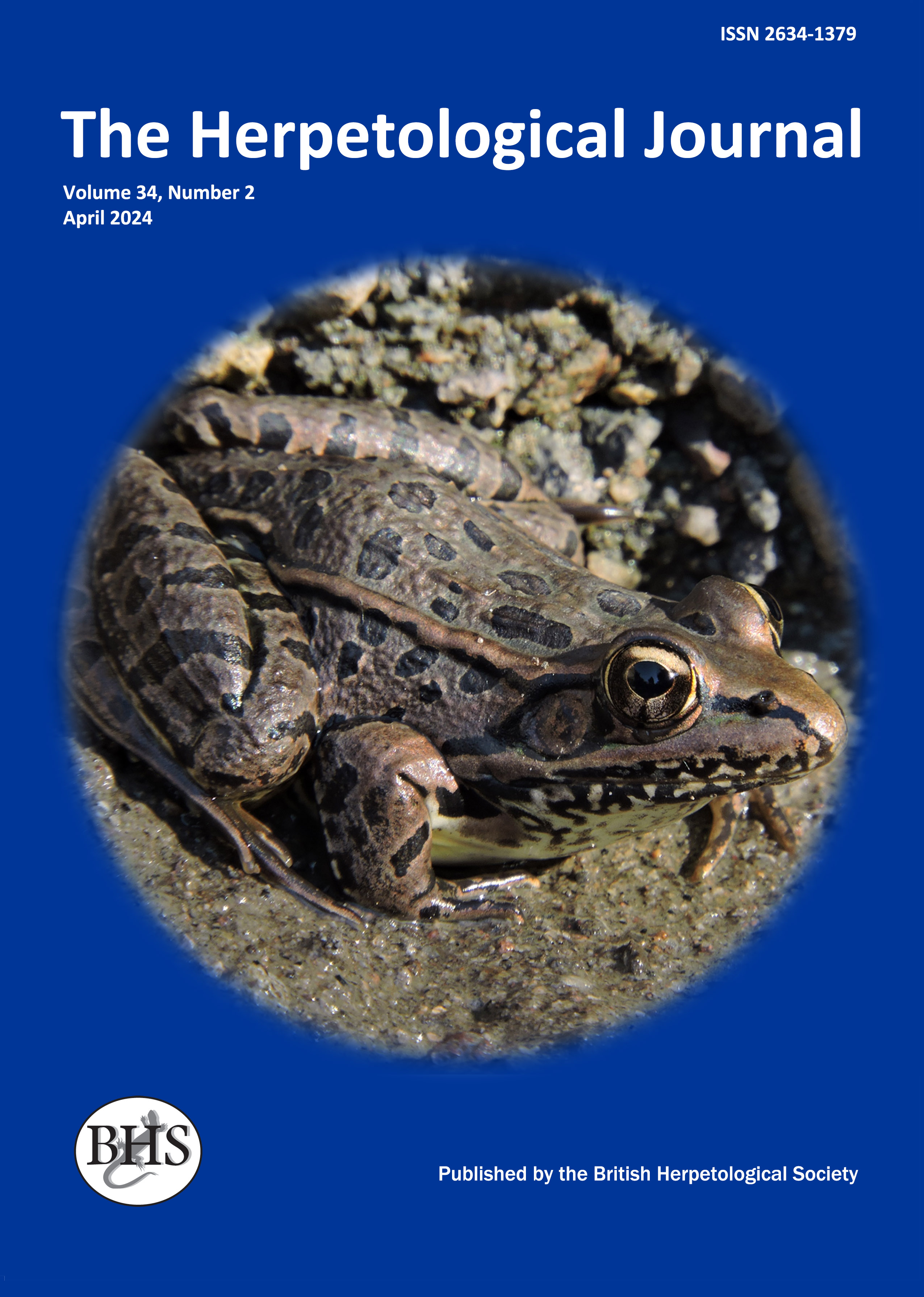
The Herpetological Journal
The Herpetological Journal is the Society's prestigious quarterly scientific journal. Articles are listed in Biological Abstracts, Current Awareness in Biological Sciences,Current Contents, Science Citation Index, and Zoological Record.
ISSN 0268-0130
2021 Impact Factor from Clarivate for the Herpetological Journal is 1.194, an increase of 0.332 from 2020.
pdf 01. Bayesian insights into Green Pit Viper Trimeresurus (Cryptelytrops) macrops sexual dimorphism with respect to influence of gravidity and habitat disturbance
25 downloads
Subscription / purchase required
https://doi.org/10.33256/33.4.8896
pp. 88-96
Authors: Curt Barnes, Colin Strine, Bartosz Nadolski, Jacques Hill III, Pongthep Suwanwaree, Taksin Artchawakom & Surachit Waengsothorn
Abstract: Sexual dimorphism is expressed in many taxa as a form of resource partitioning and as a response to unique challenges faced by male and female organisms. We investigated this phenomenon for an arboreal green pit viper species, Trimeresurus macrops, previously suggested to display obvious sexual dimorphism. We evaluated seven external characters and scaled mass index (SMI) of 73 vipers (N = 32 males, N = 41 females) obtained during night surveys and opportunistic searches in north-east Thailand from January 2015–January 2017. We utilised Bayesian inference to investigate the influence of sex, gravidity, and rural habitat disturbance on sexual dimorphism of T. macrops, and we provide 95 % highest density intervals (HDI) for the difference in means (posterior distribution). We also present ecologically relevant probabilities of observing dimorphism for each external character and SMI by sex, gravidity (gravid or not), and habitat type (rural or forest). Females were larger than males in both forested and rural habitat, females in rural habitat were larger than forest females, and all males displayed a conspicuous white eye-stripe. When gravid females were excluded from analyses, probability of observing dimorphism drastically decreased. Knowledge of niche partitioning and the specific challenges encountered by males and females, gravid and non-gravid females, and individuals persisting in rural habitats will prove valuable for conservation and snakebite mitigation of T. macrops.
ความแตกต่างระหว่างเพศ (sexual dimorphism) ถูกปรากฎในอนุกรมวิธานสัตว์ว่าเป็นรูปแบบหนึ่งของการแบ่งปันทรัพยากร (resource partitioning) และการท้าทายจำเพาะจากสิ่งมีชีวิตเพศผู้และเพศเมีย เราศึกษาปรากฏการณ์นี้ในกลุ่มงูเขียวหางไห้ที่มีถิ่นอาศัยอยู่บนต้นไม้ ชนิดพันธุ์ งูเขียวหางไหม้ตาโต Trimeresurus macrops ซึ่งได้รับการเสนอในการศึกษาก่อนหน้าว่ามีการแสดงออกของความแตกต่างระหว่างเพศอย่างชัดเจน นักวิจัยทำการประเมินลักษณะภายนอกทั้ง 7 ลักษณะและScaled mass index (SMI) ของงูเขียวหางไหม้จำนวน 73 ตัว (ตัวผู้ 32 ตัว, ตัวเมีย 41 ตัว) จากการสำรวจตอนกลางคืนและการสำรวจตามโอกาสในพื้นที่ภาคตะวันออกเฉียงเหนือของประเทศไทยตั้งแต่เดือนมกราคม พ.ศ. 2558 - มกราคม พ.ศ. 2560 เราใช้การอนุมานแบบเบย์เพื่อตรวจสอบอิทธิพลของเพศ การตั้งครรภ์ และการรบกวนถิ่นอาศัยในพื้นที่เกษตรกรรมต่อความแตกต่างระหว่างเพศของงูเขียวหางไหม้ตาโต T. macrops และเราให้ช่วง HDI อยู่ที่ 95% สำหรับความแตกต่างของค่าเฉลี่ย (การแจกแจงหลัง) นอกจากนี้ เรานำเสนอความน่าจะเป็นที่เกี่ยวข้องกับระบบนิเวศในการสังเกตความแตกต่างของลักษณะภายนอกและ SMI ตามเพศ การตั้งครรภ์ (มีหรือไม่มี) และประเภทที่อยู่อาศัย (พื้นที่เกษตรกรรมหรือป่า) การศึกษาพบว่า งูเขียวหางไหม้ตัวเมียมีขนาดใหญ่กว่าตัวผู้ทั้งที่อาศัยในป่าและพื้นที่เกษตรกรรม โดยงูเขียวหางไหม้ตัวเมียในที่อยู่อาศัยพื้นที่เกษตรกรรมจะมีขนาดใหญ่กว่าที่พบในป่า และตัวผู้ทุกตัวมีแถบตาสีขาวที่สังเกตเห็นชัดเจน ทั้งนี้เมื่องูเขียวหางไหม้เพศเมียที่ตั้งครรภ์ถูกแยกออกจากการวิเคราะห์ ค่าความน่าจะเป็นในการสังเกตความแตกต่างระหว่างเพศถูกลดทอนลงเป็นอย่างมาก โดยความรู้เกี่ยวกับการแบ่งกลุ่มเฉพาะและความท้าทายจำเพาะที่พบโดยงูเขียวหางไหม้เพศผู้และเพศเมีย งูเพศเมียที่มีการตั้งครรภ์ และตัวอย่างอื่น ๆ ที่อาศัยอยู่ในเกษตรกรรมจะพิสูจน์ได้ว่ามีคุณค่าสำหรับการอนุรักษ์และการลดปัญหาการถูกงูกัดของงูเขียวหางไหม้ตาโต T. macrops สืบไป
Keywords: Difference of body size, south-east Asia, Bayesian inference, arboreal viper

